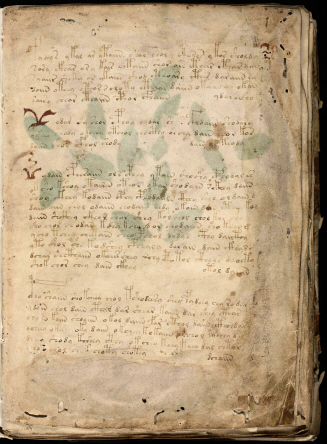 |
|
|
CHINESE SINOGRAMS IN THE VOYNICH MANUSCRIPT?
 |
|
|
Many moons ago Jacques Guy, Denis Mardle and others suggested that the Voynich may have a Chinese, or similar language linguistic connection, written in a phonetic or semi-phonetic alphabet. In a detailed explanation of this theory J Stolfi mentions that Matteo Ricci pioneered the transcription of Chinese sound into the Latin alphabet, but while I think the shapes on f1r are Chinese and that Chinese knowledge is included in the manuscript I don’t think that the general text is Chinese.
Considering my suggestion that one of the main subjects in the manuscript is the Chinese observation of SN 1054, surely there would be some linguistic evidence to support this? I believe there is such evidence and I would agree with the various suggestions that there is probably some Chinese evident in the manuscript in regard to f1r.
J, Stolfi suggests that the suspected Chinese sinograms on f1r are the product of bad copying. If the general text consisted of incomplete, anagrammed words as a means of concealing it this could have been extended to the suspected Chinese sinograms on f1r, meaning that what is there is only partially complete and would explain why it looks very Chinese to many people yet fits non of the known sinograms. I suggest the forms are deliberate rather than badly copied.
Like others that have approaches this folio the suggestion that it needs to be turned upside down binding on the right stands. Instead of adding extra letters to a word, extra stokes need to be added and the sinograms shuffled around like letters to complete a word, alternatively the sinograms may stand alone as words.
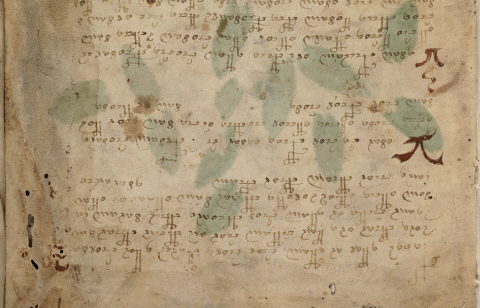 |
|
|
Below are close ups of the glyphs as seen upside down. Chinese is written in vertical columns from top to bottom, the texts running from the right to the left. Traditionally little or no punctuation was used, which interestingly is one of the properties observed in the general text in the manuscript. I will refer to the glyphs as 1, 2 and 3.
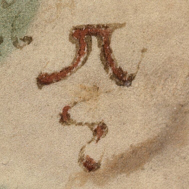 |
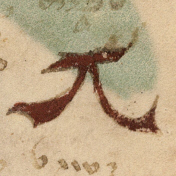 |
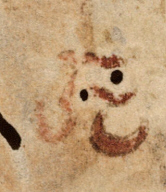 |
|||
|
|
|
Glyphs 1 and 2 are located together, 3 stands alone, this may indicate that 3 is a different word or that it is something altogether. Like J. Stolfi said this is where the guess work begins. A number of sinograms can be made by adding extra strokes; these sinograms will be considered or disregarded given the context of an astronomical theme, particularly SN 1054.
Glyph 1, legs slightly separated at the top with the right leg flicked up, and a line over the top extending out on the right with a bulge to the left. These are some of the simplest possibilities but none account for the squiqqle at the bottom, all adapted from Wiktionary (Han Characters), licence CC 3.0:
儿 = human
(basic root of the sinograph but has no top stroke)
几 = small table
how many?
a few
(right shape but lacks the extended top line)
风 = wind
air
atmosphere
(right shape, resemblance of squigglw but within rather than below main structure, but again
lacks the extended top line)
兀 = a surname
cut off the feet
元 = first
unit of curency
origin
head.
允 = grant, allow
見 = see
perceive
尢 = weak
咒 = incantation/spell/curse
Glyph 2, again legs but this time joined at the top distinguishing it from Glyph 1 and a line over the top extending out on both sides.
人 = man
person
human
(basic root of the sinograph but has no top stroke)
大 = large, high
犬 = dog
太 = very
big
extreme
great
夫 = man, husband
those
天 = sky
god
day
king (this meaning suggested by Creel (1970:501-6) to be a Zhou modification of 大 (large, high) with an extra head stroke based on 王 (wang-
ruler/king) which developed from ancient scripts. The connotations of heaven and ruler combined probably giving strengthening and giving legitimacy
to the Emperor's heavenly mandate and right of absolute rule).
失 = lose
make mistake
木 = tree, bush
Wood
矢 = arrow
Vow
禾 = grain
rice
夬 = parted
fork
certain
This is not an exhaustive list by any means but a look at some of the more obvious and simple variations of the Voynich Manuscript glyphs. From here on the stokes get very complex or the meaning is irrelevant to the subject matter, and as the Voynich manuscript glyph is not complex it suggests the complete sinograph would not be either. Some of the words above are relevant to the context of the manuscript sky e.g., plant, big, observe, sky, however the glyphs do not resemble the sinograms for “star”, “sun” or “moon” or “comet”.
Some of the very oldest star catalogues have 天 in their title as do many star names, so this may be the best choice for glyph 2, and if paired with 見 for glyph 2 could imply to “perceive or understand the heavens”, indicating astronomy, or to “perceive god” , indicating a holistic approach to the universe in its entirety and with purpose, either of these would be consistent with a work by 17th century astronomers like Tycho and Kepler.
Another means is to see which sinograms are actually found together that may form useful words. There are many combinations but given the context one particular combination stands out:
天 元
This combination has a number of alternative meanings, it literally says “round sky” or “centre/origin of heaven”. This was adopted to signify the unknown (the celestial element) in an equation in a system known as Tianyuan algebra, developed in the and then later lost to be rediscovered later, as a title this could signify the manuscript has a mathematical basis. The “Tianyuan” unknown element could refer to the unknown in the Voynich Manuscript concealed by code and could offer a clue to how to decode the text, e.g., incomplete anagrams and the subject matter. Another very good fit is for the constellation Eridanus which had two asterisms named “Tianyuan”, heavenly garden and heavenly field, but with different sinograms, the modern simplified Chinese for garden is identical but enclosed in a square but alas not invented until the 20th century, although courtyard is an original alternative. A play on words using a different sinogram is not beyond possibility though and could explain the squiggle which is very similar in shape to the constellation Eridanus. The significance of Eridanus is the presence of SN 1054 very close by to it, the vertical line and blob at the end of the right hand foot on glyph 1, possibly indicating its location at the end of the bull’s horn.
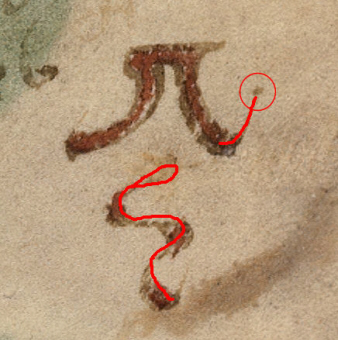 |
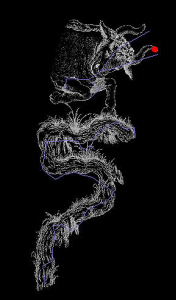 |
||
|
|
When Taurus and Eridanus are mapped onto a
Chinese style North Pole based star map it can be seen that SN 1054 lies in the
same lunar mansion (sector as the head of Eridanus.
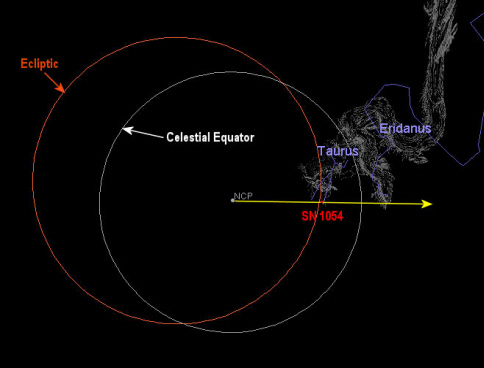 |
|
|
It is also found in the start of the Chinese concept of the universe “Tian Yuan Di Fang” (sky round, earth square), and could mean a manuscript covering sky, earth and the universe as a whole 天元地方 or 天圆地方. This “as above, so below” concept of the universe is again consistent with 17th century astronomers like Tycho and Kepler. In 6th century China the sinograms were used in royal names 天元皇帝 (Emperor Tianyuan), 天元帝后 (Empress Tianyuan), demonstrating the varied use of these sinograms "Tian" and "Yuan" in anything related to heaven, king, big, great.
In conclusion there are many possibilities, too numerous to mention here, some of which would make a title which is coherent and in keeping with the subject matter seen in the manuscript, sky, earth, the unknown, etc. Pinning any one down is like trying to catch the wind, but the possibility of Eridanus is intriguing.
Glyph 3 is located away from the other two glyphs and does not resemble Chinese on sight and as a word it conjures up Indian or Arabic or as J. Stolfi suggested even the “Om” symbol. There are holes within this area, many manuscripts have holes and other blemishes, large holes often patched up as it was not a cheap commodity to waste, sometimes they were just written around as is seen on some folios of the Voynich Manuscript. Other tiny holes occurred later due to worm damage. Bearing in mind the theme of my hypothesis glyph 3 may be an image of Taurus and crescent Moon rather than a word. Other images around the world show a star and crescent Moon and are thought to represent supernovae/nova particularly SN 1054 in relation to the crescent Moon. The star/Moon image from Chaco canyon is shown in comparison to what would have been seen from the Chinese capital on 4th July 1054 AD. The image as seen from China is shown with magnification of the Moon, which reveals it to be in a crescent part of its cycle.
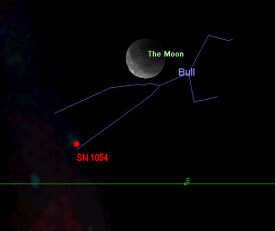 |
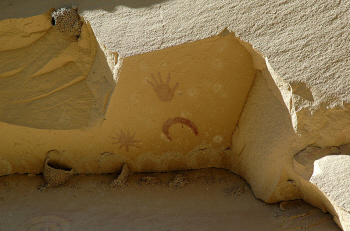 |
||
|
|
ound in the
Below is a comparison of Glyph 3 as seen only slightly off its original orientation in the manuscript, with SN 1054 as seen from the Chinese capital on 4th July 1054 AD. The crescent is technically not in the correct orientation but this is an issue with many of the suspected petroglyphs, that the
moon presented as crescent rather than in accurate orientation. But, like the other glyphs on f1r this is one consideration and may be way off the mark, but this concept does link in well once again with the subject matter being the Chinese observation of SN 1054.
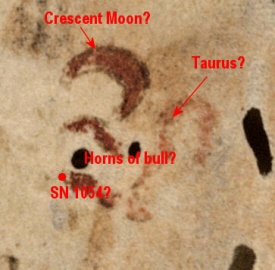 |
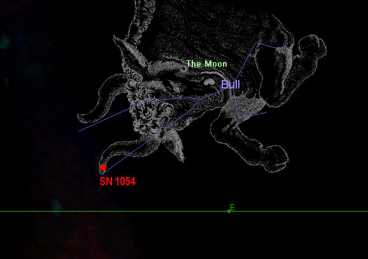 |
||
|
|
Conclusion of possible sinograms:
天
見
To understand the heavens
To perceive god
Observations of the sky
天
元
sky round (earth square) – The universe
The centre/origin of heaven
Tianyuan - algebra
Tianyuan – the unknown element
Eridanus
The name of an important person
In terms of known astronomical terms Sometimes the sky was divided into nine parts
天
九
Jiutian - "the nine sky divisions" (9 + sky) , the middle sky and the eight directions
High up in the heavens
天
光
Bright day
Bright sky
先
天
Inborn/inate
First day
大
疫
Great plague but without the 疒 "sickness" radical shown
天
咒
Heavenly curse (the supernova? plague? misfortune?)
Havenly incantations (secret knowledge?)
Great plague (but without the sickness radical)
Curse of the Emperor
All these various combinations have meaningful and contextual possibilities in relation to the manuscript. However, the last one, 天咒 has a very specific relationship to my hypothesis that misfortune came from the sky in the reign of Emperor Renzong in the form of a new and unwelcome "guest star". The Emperor was indeed cursed and although his reign saw a renaissance in science and philosophy, this renaissance was fuelled by the very misfortune, many plagues and epidemics that cursed his reign above all others.
Copyright © 2010 P. Han